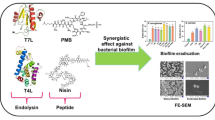Summary
An analysis of Flavobacterium sp. strain 304 variants selected for flocculation deficiency and phage resistance has been carried out. The results show that flocculation is efficiently hindered by overexpressed protein in the outer membrane or carbohydrate on the cell surface. The floc-forming protein is suggested to be a minor component of the cell surface. The 12 flocculation-deficient and five phage-insensitive variants obtained were grouped into ten classes based on nine characteristics. In addition, bacteriophage φ304 resistance and the pure culture flocculation deficiency of this strain are interrelated.
Similar content being viewed by others
References
Benedict RG, Carlson DA (1971) Aerobic heterotrophic bacteria in activated sludge. Water Res 5:1023–1030
Bradford MM (1976) A rapid and sensitive method for the quantitation of microgram quantities of protein utilizing the principle of protein-dye binding. Anal Biochem 72:248–254
Endo T, Nakamura K, Takahashi H (1976) Pronase-susceptible floc forming bacteria: relationship between flocculation and calcium ion. Agric Biol Chem 40:2289–2295
Gerson DF (1980) Cell surface energy, contact angles and phase partition I. Lymphocytic cell lines in biphasic aqueous mixtures. Biochem Biophys Acta 602:269–280
Gray NF (1989) Biology of wastewater treatment. Oxford University Press, Oxford, UK
Hantula J, Bamford DH (1991) The efficiency of the protein-dependent flocculation of Flavobacterium sp. is sensitive to composition of the growth medium. Appl Microbiol Biotechnol 36:100–104
Hantula J, Kurki A, Vuoriranta P, Bamford DH (1991a) Rapid classification of bacterial strains by SDS-polyacrylamide gel electrophoresis: population dynamics of the dominant dispersed phase bacteria of activated sludge. Appl Microbiol Biotechnol 34:551–555
Hantula J, Kurki A, Vuoriranta P, Bamford DH (1991b) Ecology of bacteriophages infecting activated sludge bacteria. Appl Environ Microbiol 57:2147–2151
Hofnung M, Jerzierska A, Braun-Breton C (1976) lamB mutations in E. coli K12: growth of λ host range mutants and effect of nonsense suppressors. Mol Gen Genet 145:207–213
Kurki A, Hantula J, Vuoriranta P, Bamford DH (1989) Floc formation mechanism of activated sludge bacteria. Water Sci Technol 21:1637–1638
Lenski RE (1987) Dynamics of interactions between bacteria and virulent bacteriophage. Adv Microb Ecol 10:1–44
Maniatis T, Fritch EF, Sambrook J (1982) Molecular cloning: a laboratory manual. Cold Spring Laboratory, Cold Spring Harbor, N. Y.
Mindich L, Bamford DH (1988) Lipid-containing bacteriophages. In: Calendar R (ed) The bacteriophages, vol 2. Plenum Press, New York, pp 475–520
Olkkonen VM, Bamford DH (1989) Quantitation of the adsorption and penetration stages of bacteriophage ϕ6 infection. Virology 171:229–238
Palva ET (1978) Major outer membrane protein in Salmonella typhimurium induced by maltose. J Bacteriol 136:286–294
Wheathley AD (1985) Wastewater treatment and by-product recovery. In: Sidwick JM (ed) Topics in wastewater treatment —critical reports on applied chemistry, vol 11. Blackwell, Oxford, pp 66–106
Author information
Authors and Affiliations
Additional information
Offsprint requests to: D. H. Bamford
Rights and permissions
About this article
Cite this article
Hantula, J., Bamford, D.H. Bacteriophage resistance and flocculation deficiency of Flavobacterium sp. are phenotypically interrelated. Appl Microbiol Biotechnol 36, 105–108 (1991). https://doi.org/10.1007/BF00164708
Received:
Accepted:
Issue Date:
DOI: https://doi.org/10.1007/BF00164708




